The official newsletter of the Loyola Film Circle. Managed by Documentations and Publications. Header done by Ida de Jesus.
Don't wanna be here? Send us removal request.
Text
“There was an idea...”

by Renzo Guevara
edited by Anna Cayco
Avengers: Infinity War (2018) is the 19th film in the Marvel Cinematic Universe (MCU), a franchise that has been relatively consistent in terms of quality and vision for the last 10 years. It’s the massive culminating event that has constantly been set up with the three phases of movies with each of the individual heroes’ adventures leading up to this film.
But Marvel’s massive reputation and cultural impact was not as prominent as it is today. They sold some of their most recognizable characters’ movie rights to other companies such as the X-men and the Fantastic Four to 20th Century Fox and Spiderman to Sony. Their first movie, Iron Man (2008) was a risk to say the least. The concept of an Avengers movie was merely just a thought but never an actual legitimate vision. A fun little innocent scene was placed at the end of the credits, showcasing Samuel L. Jackson’s now iconic character Nick Fury showing up to talk to Robert Downey Jr.’s Tony Stark about the Avengers initiative. Conversations about this scene grew until Marvel Studios revealed its plan to produce more superhero movies to lead up to an Avengers film. Thus, the MCU was born.

The first real culminating event was 2012’s Avengers directed by Joss Whedon. To say that the film was a success is an understatement compared to how exactly fans and critics responded to it. It featured breathtaking action sequences, entertaining interactions between the characters and a carefully crafted three-act structure that successfully combined all the elements that were set-up during the standalone movies. Included in Phase 2 was its sequel, Avengers: Age of Ultron (2015), which featured new characters such as Scarlett Witch, Quicksilver and Vision. Unlike its predecessor, it was met with mixed reactions between the audience and critics. Some commended it for the sheer spectacle on display and seeing our heroes assemble again but in time people soon accepted the fact that the film had a disjointed narrative, a disappointing villain and a few unlikeable characters.
Regardless, these first two Avengers films successfully assembled the heroes and characters we’ve all come to love. It’s not wrong to say that some of us may have garnered some sort of attachment to them that naturally makes us care for what happens throughout the series, especially in Infinity War where stakes are at an all-time high with talks of possible permanent deaths and ending of contracts of certain actors.

What could possibly have created this attachment to this universe is how these movies always tried to set themselves apart not just in their tonality also in the production behind it. The directors the studio hired were not your typical action filmmakers but were more story, character and comedy focused. And it’s also not uncommon to see the MCU go with the recent trend of giving blockbuster projects to directors who mostly made a name for themselves in the indie scene or in television. Filmmakers Anthony and Joe Russo, who were mostly known for the TV series Community (2009-2015), were hired for Captain America: The Winter Soldier (2014) and then for Civil War (2016). Both films were met with commercial and critical praise. With engaging plots that were grounded in reality setting it apart from the rest of the MCU, it was a clear choice for Feige to call upon the Russo brothers again to work their magic. And boy did they deliver with Infinity War.
The 3rd Avengers film features an incredible roster of every hero that has been established alongside the Guardians of the Galaxy. This feat has been so monumental in scale and scope that it has often been regarded as the most ambitious crossover event in cinematic history and if I’m being completely honest, it definitely earns that title.
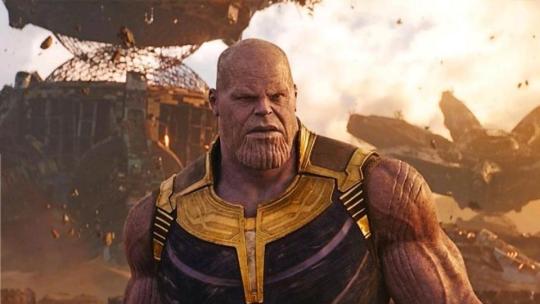
Immediately, the film starts off incredibly strong with the chilling rightful introduction of the main event, Thanos. Gone are the days of post credit setups or small cameos, here we are placed face to face with him alongside his team who are not to be messed with. Thanos as a villain is truly an achievement for the film. You would think that him being a purely CGI creation would make him feel weightless and absent but that’s far from the case. Josh Brolin gives a hauntingly calculated performance that was beautifully motion captured as real emotions were seen, and true terror was felt whenever he was on screen. The MCU has always faced criticism about its villains but recently they have been nailing it in that department especially with Thanos. When people say that Infinity War is a Thanos movie instead of an Avengers one, it’s a valid statement to say. This is ultimately Thanos’ story and the Avengers are simply background characters. Some could even look at them as the real antagonists of the story as Thanos’ actions may be grim but once you deconstruct his motivations, they actually present a proper argument to a certain extent.
A massive cast is something that’s unavoidable with this being a culmination of 10 years’ worth of movies. At times, the film, struggles with the weight it has to carry as it tries to give each character their own individual adventures that all come down to stopping Thanos. Despite this, it doesn’t feel overly bloated. Each of the heroes get a decent amount of screen time. Some may shine more than others, but this can easily be forgiven given that this is technically a two-part storyline and the film was already nearly three hours long.

Considering the run time, the film is still a rollercoaster ride that rarely lets you take a breather. Just from the very first shot all the way to the last you will be left speechless and in pure state of either awe or shock. If in previous MCU movies, the stakes were rarely felt and a sense of danger was minimal, Infinity War turns this over your head and whacks you with it continuously. I wouldn’t say that there were certain throwaway scenes that could’ve been left on the cutting room floor but there were definitely some moments where I was more invested in than others. This can mainly be due to personal attachments to certain characters or just a simple desire to get back to the action. Character moments between our heroes are highly entertaining with the filmmakers and writers taking advantage of each of their quirks and antics that play off of each other. But what’s more impressive is that in its core, the identity of its characters remains intact. When the Guardians are on screen, it feels like a Guardians movie and so on.
But it’s also worth noting that some characters may not act the way we were accustomed to them in their solo movies. This should be expected given the difference of directors and writers and visions towards what and who they are. None were too different to the point where it’s a complete 180 of a character trait but just subtle enough to be noticed a bit or can be argued as part of their arc.
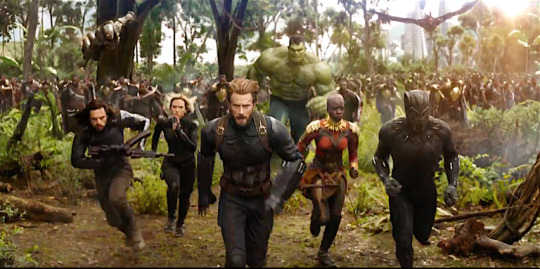
The action sequences in Infinity War are spectacle in its purest form. The Russo brother’s first two films in the MCU, The Winter Soldier and Civil War both contained amazing action scenes but most of them would regularly use quick jump cuts and an overly reliance on shaky and handheld camera work. Infinity War is arguably their first “fantastical” movie as their previous projects in the Captain America franchise were mostly grounded in reality. Thankfully they improved their craft in this one utilizing mostly wide shots and steady cams. The fight choreography and the breathtaking visual effects that supplement them invoke an epic feeling that is so much more emphasized with the familiar iconic score of the Avengers theme. One moment in particular near the climax had all these elements come together to create one bombastic moment that had the entire theater screaming in delight.
On the topic of the Avengers theme, Alan Silvestri’s score for this film also deserves much praise for what it accomplished. Although it should be expected given that the Avengers score is one of the most recognizable themes today, Silvestri’s new pieces in this film are as memorable and impactful as the scene themselves. The action sequences are injected with auditory adrenaline rush coupled with the masterful sound design and mixing but even the slower, more emotionally driven moments in the film contain some of the best scores to come out of the MCU.
All in all, it really was incredible to witness the development of the MCU franchise from its humble beginnings with Iron Man all the way down to Infinity War. All the stories the directors have told and all the elements they had to set up all coming into fruition in this one epic cinematic event. The Russo brothers deserve all the praise they could get for accomplishing this monumental task. Many have tried and failed to launch a cinematic universe such as the DCEU or Universal Studio’s Dark Universe, but it’s with the MCU that truly believes in its own vision and in the stories they tell.
All the beats in Infinity War hit when they need to. Wonder and spectacle alongside tension and emotion jell together for one massive sweep that generally satisfies majority of the hype that developed over the years. A global cinematic event that deserves to be seen and a proper payoff to all those years of excellence. Infinity War is definitely up there with the best of the MCU and it cements itself as one we would be talking about years down the line. The future of the franchise looks bright and with the continuation of the storyline scheduled to release next year, it’s only a matter of time till we see our favorite heroes assemble once again.
Photo sources: 1 2 3 4 5 6
3 notes
·
View notes
Text
FLC 4: Science in 80s Sci-Fi

by Matthew Fernandez
edited by Benjie Bernal
It was a surreal, garish image: a man with ripped muscles and torn clothes stood defiantly in a sea of rubble— remnants of a fallen, crumbled city. Holding him on both sides were two scantily-clad, neon-skinned women. A robotic figure of dazzling chrome scanned in the background. Planets loomed in the crimson horizon. Bolts of lightning peppered the sky. The picture looked like it belonged on the cover of some pulp sci-fi magazine. To lecturer and self-professed cinteaste Ronald Cruz, it was a perfect depiction of “the zaniness, the weirdness, the craziness of 80s sci-fi. Because that’s what it is, really.”
Eighties science fiction, with its cyborg assassins, glowing space aliens, and not to forget time travelling sports cars strikes most as fantastical and over-the-top. But no matter how madcap the genre can get, you can’t have science fiction without, well, science. April 20th marked the Loyola Film Circle’s fourth and final Film Literacy Class for 2018, which saw Ronald Allan L. Cruz, Ph.D. (cand.) of the Biology Department discuss the real-life scientific concepts behind the decade’s iconic sci-fi flicks.

According to Cruz, the 80s era served as one of the highest peaks for science fiction. “Some of the best movies to come out in the genre came out during that decade,” Cruz noted. And the amount of regarded classics, as does the numerous subgenres these films have made, as Cruz mentioned, indeed exemplified this. The gritty and futuristic cyberpunk subgenre saw hits such as Blade Runner (1982) and RoboCop (1987). The sci-fi/horror hybrid that is body horror, or biological horror, drew audiences with vile imagery pervasive in David Cronenberg's 1986 remake of The Fly and in John Carpenter’s The Thing (1982). Extraterrestrials invaded the big screen as well, ranging from action gorefests Aliens (1986) and Predator (1987) to the more family-friendly E.T. the Extraterrestrial (1982). The concept of time travel also made a huge impression on moviegoers, with films like The Terminator (1982) and Back to the Future (1985) utilizing the idea as a major plot device.
The films Cruz mentioned epitomized the good and the peculiar in the genre, but what’s more interesting is the fact that they rely on some form of science to explain its main premise. Cruz continues, telling about how our world today is poised to become a mere reflection of the bizarreness present in 80s sci-fi. And that the amalgamation of man and machine as seen in RoboCop is not too far off when you consider people such as Kevin Warwick and his artificial, Internet-connected hand or Neil Harbisson’s synesthetic “eyeborg”. Even the nearly-human Replicants of Blade Runner seem closer to reality with the advent of 3D-printed organs and tissue.
Gene splicing, the process of incorporating foreign DNA to one’s own, could explain the horrific metamorphosis Seth Brundle undergoes after his DNA was mixed with a housefly’s. The humanlike morphologies of the xenomorphs, yautja, and even little E.T. can be stemmed not just from cost-cutting measures for costume designers at the time, but also from the Panspermia hypothesis, which speculates that life on Earth is but one of the planets “seeded” by a common source, implying that there are beings similar to us throughout the galaxy.

Finally, the far-out concept of time travel has produced numerous hypotheses on the possible principles it adheres to. Back to the Future’s take on time travel hinges on the concept of a single timeline that may be affected by changing past or future events, echoing the Butterfly Theory but foregoing the Novikov Self-Consistency Principle which establishes that the general flow of the timeline remains uniform no matter what events are changed, preventing paradoxes and alternate timelines.
The sheer amount of concepts Cruz explained is a big lot to take in, and that’s not even scratching the surface, stating: “There’s so much more I could say about science fiction in the 80s,” while enumerating the many, many other films he hasn’t touched upon. “There's so much more to watch,” he adds, “I encourage you—especially you being film buffs—[to] watch as many as you can.”
Cruz closed our discussion with the advice he’d often impart to his students in his Biology of Science Fiction class. “When I explain the science in science fiction, it's not meant to burst bubbles. [...] That's not the point. The point of understanding the science behind the science fiction that you watch is to gain a whole new [level of] appreciation,” Cruz said, finally concluding the lecture stating: “Because your appreciation for a piece of science fiction will be so much more enhanced and intellectual if you know the science behind it."
#matthew fernandez#benjie fernandez#event coverage#flc#back to the future#ronald cruz#prediksi skor#sci fi
1 note
·
View note
Text
FLC 3: FPJ King of Filipino Action Films
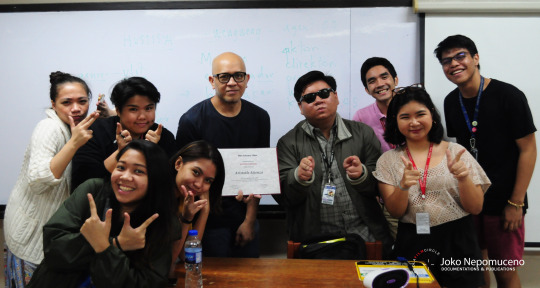
by Renzo Guevara
edited by Jessica Brown
The third FLC on the legacy of Fernando Poe Jr. was held on Monday, April 16 and was spearheaded by Aristotle Atienza of the Filipino Department. Atienza graduated with a degree in AB Filipino Studies in 2002 and a Masters in Philippine Studies in 2011 at the University of the Philippines Diliman, thus making him the perfect person to talk about this topic.
To understand this era of film, he deconstructed who Fernando Poe Jr. or FPJ was and how he acquired the titular title of “Da King” in Philippine cinema. He garnered this title with a list of 258 projects in his filmography which reflects the history of the Philippines from pre-colonial to contemporary. Beginning with his first movie, Anak ni Palaris (1955) and ending with Pakners (2003), he has won 20 Filipino Academy of Movie Arts and Sciences Awards. On top of this, he acted and delved in directing and writing under the alias ‘Ronwaldo Reyes’.

FPJ’s movies are primarily action, a genre that is mainly viewed as shallow and lacks the ability to open up creativity and depth to the medium. Filmmakers have done their best to subvert audience’s expectations by culminating other genres of film and mashing them up to form a central theme for the narrative. His movies usually fall into the genres of bakbakan, sword films, war films, spaghetti western, and espionage or even detective films. Examples of these would be Ang Panday (1980), Lo’Waist Gang (1956), and Anak ng Bulkan (1959).
Family was also a big theme in FPJ’s films and is seen through favorites such as Gawa na ang bala na papatay sayo (1989) and Wanted Pamilya Banal (1989). Family was not bound by the definition of having the same blood but includes those who are close to you.
Atienza further cemented FPJ’s status of being the King of Philippine Cinema by stating that the characters he portrayed covered a wide variety of jobs or positions such as a mining expert, an ex-soldier, and a knight. He also portrayed an outsider who was an ex-convict that was ridiculed by society. Through these characters, he was able to create an interesting conflict of morality within the story of the film.
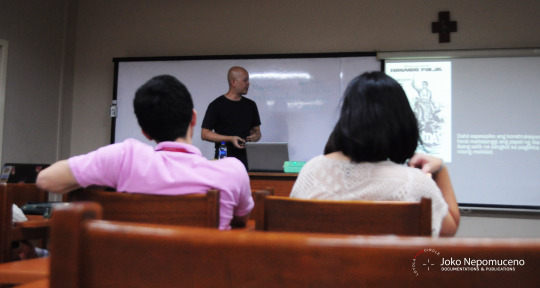
If one were to compare the action stars of today to FPJ, there was a clear difference between how they presented themselves and how they went about their respective films. Robin Padilla was used as an example by Ateinza as he had a stoic, cold, cruel, “cool” demeanor; meanwhile, FPJ had humility, and was a family man willing to take action for the sake of justice and peace instead of spectacle.
Atienza said that film genres change based on the needs of the times. Modern action franchises such as the Enteng Kabisote franchise is described by Atienza as a fantasy action failed to tackle social justice or relevant topics that films FPJ made. Yet, there is also a trend in indie action movies, particularly ones by Erik Matti. He then presented a thought-provoking question to us all: With the recent trend of action movies trying to come back, does it signify a call for justice in today’s society?
We may never get someone as special as Fernando Poe Jr. again and that is something we must be okay with. The legacy he has left was truly something to behold and look back on with a special nostalgic factor for the old cinematic practices and filmmaking. As for the new generation of action films, it is nice to see that these films have not died, and that these films truly boomed due to an icon that is, to this day, very much alive in people’s hearts.
If there is one thing we could all agree on, it is to say: long live the King.
4 notes
·
View notes
Text
FLC 2: Martial Arts in 80s Film
by Anna Cayco
edited by Dane Santiago
The second installment of the Film Literacy Classes held last Friday featured Sir Takehisa Matsuko from the Japanese Studies Department. Matsuko also invited his good friend, Ms. Camille Bautista-Espinola to explain the art of karate and a few of its applications in film. Bautista-Espinola is trained in various martial arts but found her heart in the strongest form of karate, kyokushinkaikan. She is a third degree black belt and four-time National Champion in Asia Kumite.
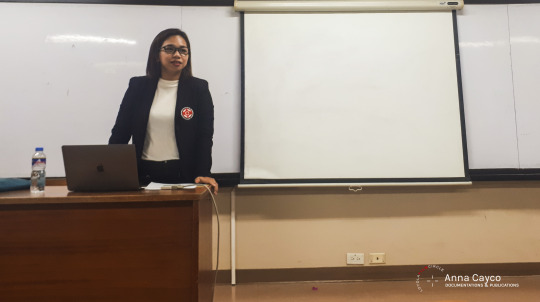
Bautista-Espinola explained how it is normal for a trainee to end up in the hospital after a session since it is a full contact sport with no armor involved. The brutality of this sport is what made karate so popular in the 80s. The creator of kyokushin, Masutatsu Oyama, has captured the attention of news outlets worldwide, especially when he decided to hold world tournaments in Japan. Bautista-Espinola said that the rise of martial arts in film could be attributed to this.
However, Matsuko said that karate is not just a sport; it is also a philosophy. Karate is the training of one’s mental state and discipline as well as of their physical strength. While Hollywood martial arts films—such as Big Trouble in Little China (1986) and No Retreat and No Surrender (1986)—tend to focus on the action scenes instead of on the character development and plot, there are some gems in the pile that indeed showed Matsuko’s taking from karate: the beloved The Karate Kid (1984) showed the gradual improvement of Daniel (both in the sport and in the philosophy of karate) through Mr. Miyagi’s eccentric training sessions, with the film even implying a bridging of cultures between America and Japan, especially seen when Daniel goes with his mentor in the sequel.

The industry for martial arts films has declined after the 90s, but we do see better choreographed fighting scenes today in places you would least expect. Bautista-Espinola said that local mainstream production houses have reached out to her organization to choreograph fighting scenes to make them more believable. Even though the situation might not be as authentic, she still tries to keep the art form intact through explanations and such with the actors. With the experts handling the choreography, the intensity of martial arts is not lost. At the end of the class, there was definitely a newfound appreciation for the sport and how it transitions to film.

0 notes
Text
Film Review: Three Billboards Outside Ebbing, Missouri

by Benjie Bernal
edited by Anna Cayco
*Spoilers ahead
Mildred Hayes (Frances McDormand) is a mother who puts up three controversial billboards outside of the mid-Western town of Ebbing Missouri for the lack of progress for the rape and murder of her daughter. The bright orange signs strikingly read: “Raped while dying”, “And still no arrests”, and “How come Chief Willoughby?” The film is a battle amidst emotions: with Mildred’s relentless hunger for justice—headstrong and motivated—versus a town that inherently supports her, but continuously calls for her to be more understanding, if not yield her efforts.

Throughout the film, Frances McDormand’s portrayal of an unhindered Mildred is flawless as the cops’ attempts to bully her are no match for her stone-cold personality as she continuously pokes innuendos of the cops’ reputation for brutality, making the dynamic between her and the cops serious, while at the same time oddly playful and amusing. But when Bill Willoughby (Woody Harrelson) appeals to Mildred for pity disclosing that he has cancer, Mildred, having already developed an ruthless sense of apathy, ignores his appeal. And just as the movie reaches a stalemate between Mildred and the cops’ for the billboards, Bill, with the harmless intention of not wanting to have his family have a bad memory of him dying of cancer in the succeeding months, kills himself, therefore framing Mildred’s billboards as the cause of Bill’s suicide. As a marvelous battle of violent emotional reactions is set off across the town, it’s clear that Mildred isn’t the only one angry in the town anymore: it’s everyone— at her.
In this battle, writer and director Martin McDonagh’s screenplay shines, overtly highlighting the police’s racist, homophobic and violently impulsive tendencies. This is through the character of Jason Dixon (Sam Rockwell), who’s humorously known throughout the town as one of its racist and impulsive cops. Sam Rockwell amazingly absorbs his role as the stereotypical impulsive moron, who at one point goes as far as brutally assaulting and then throwing the billboard manager out a window in a beautiful one-take sequence that speaks multitudes about the social issue. But Jason’s Character isn’t just for the movie to make its political gesture. Martin at the same time ingeniously highlights Jason’s relationship with his mother that despite being old and frail, we see that hate is indeed something that’s enculturated and learned. But the absolute highlight of the film is the letter sent by Bill Willoughby before his death that sends Jason Dixon on a path of redemption practically resembling Darth Vader’s in the last moments of Star Wars: The Return of the Jedi (1983). Jason gets an intense visible change in his character, and not just because he himself gets brutally disfigured, but because he finds new emotions to fuel his actions and the film portrays this shift with a correlation in how he treats and gets received by people.
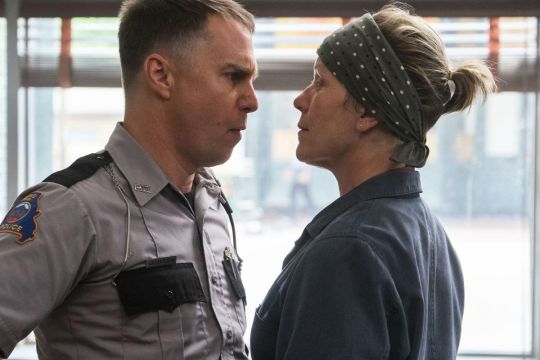
Three Billboards is it doesn’t just simply follow along in Mildred’s affliction of seeking justice or attempt to highlight the pain of her loss— which the film actually does well with the peculiar dialogues she has with herself, a flashback sequence, and the portrayal of a scarred family — but also emphasizes the senseless anger and tendency for violence and disparity people have when they deal with loss. Dormand and Rockwell's performances encapsulate the complexity of their grief. No wonder they both won Best Actress and Supporting Actor respectably in this year’s Academy Awards. Two two’s propensity to keep on creating conflict are contingent, making the battle in, or more specifically of, the Three Billboards a joy to watch.
Photo sources: 1 2 3
0 notes
Text
Never Not Love You is the Film of Our Generation

by Anna Cayco
edited by Jessica Brown
Lead actors Nadine Lustre and James Reid have been known to live outside the familiarity of showbiz love teams. With Antonette Jadaone, who directed That Thing Called Tadhana (2014), at the forefront as its director and writer, there was high expectation for the film to not be a typical Philippine romance film.
And it is. Never Not Love You (2018) is the love story of our generation.

Let’s address the elephant in the room. The cinematography and editing are world class, and this can be seen in scenes such as the tattoo shop where Gio (Reid) frequents, the grand urban streets of London, or the bright yellow mountains of Joanne's (Lustre) home in Zambales. Potentially, this may have been done It could to appeal to a generation that constantly sees high definition landscape and urban photography on their timeline. This is reflective with visually stunning films such as Kita-Kita (2017) and Siargao (2017). What is refreshing, however, are the small moments the camera captures in equal quality, such the embraces Gio and Joanne share in bed after a long day at work.
What makes the film stand out from the other Philippine romance films is the verisimilitude of the conflict. The film does away with cliches found in similar mainstream films. Nobody is diagnosed with terminal cancer. Nobody cheats. My expectation of a car accident was very much not met.

The drama, instead, is internal. It arises from the clash of ambitions among Gio and Joanne. After being cut-off from his father, Gio is forced to find stability in his very unstable profession, freelance graphic design. With the choice to take a job in London, he risks being separated from Joanne for who knows how long. Joanne, on the other hand, has fought tooth and nail to get a position in a high-profile marketing firm in Makati and is about to be promoted as brand manager. To leave the Philippines would be corporate suicide.
This is a problem that many young professionals – or any Filipino for that case. Better opportunities do exist outside the country. However, what often isn't considered are the repercussions that come with moving.
Gio doesn't deal well these repercussions. He is our typical bad boy (a character that Reid has played before) who sees the world in black and white. For him, it's either giving up his dream to stay with Joanne or forcing her to leave her dream and go with him to London. Joanne is left with little to choose from.
Eventually, she chooses to move to London with him, becoming miserable when she downgrades to waitress while Gio is living his dream. When she tells Gio she wants to return back to Manila, he lashes out, calling her selfish and ungrateful..
We don't like Gio. On the one hand, We want them to break up. On the other hand, we also don't want them to break up and waste all the moments they've gone through. What we do want is Gio to change.
He does change, but not enough to catch up with Joanne. He learns to set her free and they decide to have a long distance relationship. Joanne instantly gets her life back together back in Manila. She gets a car for herself, uplifts her family from poverty, and is happy with her own group of friends. Gio, however, is doing well in London yet still has his bouts of anger against Joanne. It comes out through flashes of jealousy in seeing her celebrating with a male friend or even as small as a side-comment on the color of her new car.

He knows that Joanne has outgrown him. After two years, he returns to Manila and confesses to Joanne, "I'm in love with this Joanne in my head. And in my heart... but when I look at you now, I don't know. It's different."
They don't break up. They never broke up throughout the entire film despite all the fighting and distance. Joanne reassures Gio that they will make it work. If anything, this is a lesson that every person of this generation needs to know. Self-love is equated to dropping toxic people like hot potatoes but we will never find a person who we love that is incapable of hurting us.
Right before the ending, Gio and Joanne return to the tattoo shop to get their tattoos - bands of blank ink on their ring fingers - retouched. Indeed, love can fade but love can also be saved.
Photo sources: 1 2 3 4
Special thanks to the JaDine Nation for inviting us to watch the film!
#never not love you#james reid#nadine lustre#jadine#film review#anna cayco#jessica brown#jadine nation
2 notes
·
View notes
Text
FLC 1: What Makes 80s Horror Iconic?

by David Belmonte
edited by Joshua Chan
Let’s face it—how often do you get to sit in a class after hours to listen to an hour-and-a-half lecture about the 80s? The Loyola Film Circle launched its first Film Literacy Class of 2018 on the 16th of March, hosted by none other than Mr. Andrew Ty of the Communications Department. While the talk itself was titled “What Makes 80s Horror Iconic”, those familiar with the eccentric communications professor would know that there was a lot more to discuss than the subject matter alone.
In fact, the first half of the class almost served as a love letter dedicated to his life growing up in the 80s. He recalled how getting in touch with the media opened him up to the countless worlds that existed beyond the silver screen— be they be worlds with masked murderers, scantily-clad vampires, or shape—shifting aliens. According to Ty, the 80s itself as a whole has become iconic to our generation.
With the sudden reappearance of music and fashion from the days of neon, skateboards and leg warmers, one could argue that the 80s have become a trend; an aesthetic. Pop culture and media from a long-gone era have become recognizable to us despite having not lived through it.

Ty believes that the past has become commodified through media’s depiction —painted in gold to hide its blemishes. In relation to horror films, such commodification creates a “recognizable look and style.” In order to understand what makes 80s horror so iconic, we must first try to peg what this recognizable look and style is.
One thing that separates 80s horror from its more modern counterparts is the visuals - the flair. There’s nothing more attractive than a tinge of tasteful slaughter. “A lot of 80s horror is not very good, but they have a sense of style.” He brought up the renowned 1984 slasher film A Nightmare on Elm Street to prove his point, stating that the film had a lot more style than substance. In his words, it was “ridiculous” but of course, that’s part of the reason why the movie became so iconic in the first place – over-the-top blood and gore partnered with cutting-edge special effects that formed visually appealing scenes. It was fresh, it was original, it was “absolutely strange” and “absolutely powerful.” There was nothing quite like it. Its “ridiculousness” is the reason why A Nightmare on Elm Street is the definitive slasher movie.
However, style alone isn’t enough to define 80s horror. Some arguably bad horror movies such as the 1980 film Friday the 13th is mainly considered iconic due to the sheer presence of its villain, the captivating, lumbering, and nearly unstoppable Jason Voorhees. While Ty argues that the Friday the 13th series is pretty much a bad series, the presence of Jason Voorhees was so iconic that even people who didn’t like the films were drawn to it.
Additionally, there’s more to 80s horror than just style and villains. One must remember that 80s horror wasn’t built by special effects and camerawork alone, for a big chunk of 80s horror comes from literature. No, not the novelization of Top Gun, but rather, the works of Stephen King, which were rich in not just the supernatural, but also adult themes. King’s importance is highlighted by the fact that a large number of his novels have been adapted into films or television series; many of which have been well regarded by fans and critics alike.

Ty then claimed that King’s book covers played a large role in his success. This was because more often than not, King’s name would appear at the top of the book in larger text than the actual title. It’s an easily recognizable design, and that’s exactly what makes it so iconic. Ty says: “Make a book look like a Stephen King book and it’s guaranteed to sell”. While the film industry was a giant part of 80s horror, literature was also a big contributor to it.
Ty then ended the class with a quick Q&A where he ended up talking about some of his favorite Filipino horror flicks such as the Shake, Rattle & Roll series, or the 1988 horror-thriller Tiyanak. He even mentioned that when he first saw the teasers for the latter, he thought to himself “Number one, that looks horrible. Number two, that looks horrifying. Number three, I kind of want to watch it.” This sums up 80s horror in a nutshell – despite its potential cheesiness, it is something that draws with its aesthetics. Deep down inside, these frights are everything one could ask for.
1 note
·
View note
Text
War is a Mess but this Movie isn’t
by Benjie Bernal
edited by Franco Luna
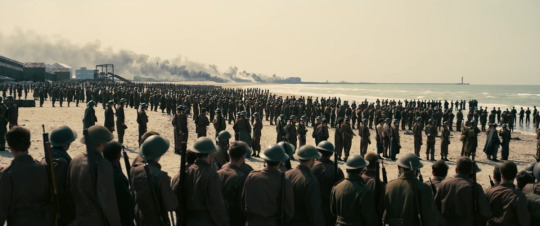
After three long years of waiting for another Christopher Nolan film, fans such as myself are wonderfully greeted with his take on the allied evacuation of Dunkirk during the early phases of World War II.
Early on in his directing career, Nolan always had a keen mind for storytelling as a lot of his earlier films feature unconventional narratives that aren’t chronological. One of his earlier films which people have overlooked but has recently been gaining traction is Memento (2000). It features a character with amnesia, and revolves around him retracing his steps whilst discovering shocking and misleading revelations, making for a narrative that reveals key plot twists at will, all coming down as a gripping, refreshing take in the crime genre.
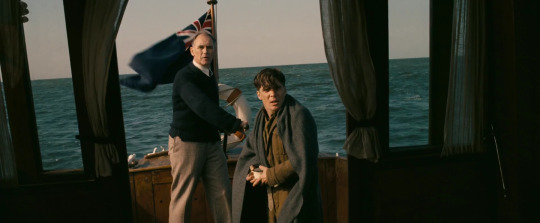
Nolan’s films are often his own personal takes of the usual genres such as action-thrillers and sci-fi, while incorporating his unconventional style of storytelling that makes for an immensely refreshing cinematic experience. However, there’s something to Dunkirk that’s special in comparison to his previous films. It’s that this time, aside from Nolan once again demonstrating his masterful control of the audience’s perception of time, he pushes it to another level as he delivers a narrative that isn’t reliant on dialogue or characters to achieve dramatic effect. Instead here he pushes what the fundamentals of film can do, it being: visuals, sound and editing.
With his sensational use of time and editing, its almost poetic (and just plain creative and original) how Nolan envisioned the sequencing of events in Dunkirk especially with regards to the ending where all three of the film’s story arcs finally intersect. It’s reminiscent of the ending of The Dark Knight Rises (2012) where one of the characters narrate a closing statement, the picture cuts from one emotion-evoking shot to another. In Dunkirk, the experience is a montage of the beautiful resolutions of all three storylines, while one of the characters narrates Winston Churchill’s iconic speech of the time.
With the beautiful ending it has, Nolan has managed to circumvent the idea that a war film has to conform to the ‘Brothers in Arms’ style of depicting soldiers in war where the film has tell a story of the bond soldiers share in warfare. This is essentially what we find in Saving Private Ryan (1998), and TV series such as Band of Brothers (2001), and The Pacific (2010). Here, Nolan chooses not to depict the hardships of soldiers in warfare through their interconnected relationships. Instead, he uses a tells the narrative through a lens that immerses the viewer within the event with a special emphasis on sense and realism, portraying from multiple perspectives an entire army in desperation— or how the film makes it feel— deliverance. This is done through the beautiful synergy between all the movie’s cinematic elements. On how the picture cuts from one storyline to another, or how it uses suffocating moments of tension in combination with a heart-wrenching score to create an experience that feels as constricting as being in the horror yourself.
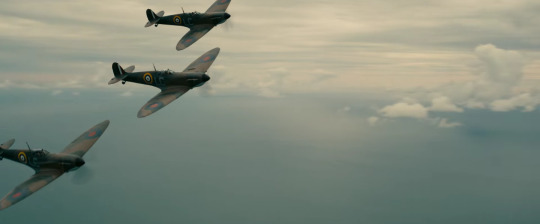
The film runs for barely two hours, yet leaves you with very little time to breathe as it feels like every moment is brimming with tension. Even seemingly mundane scenes are tense as viewers can seldom feel the emotional transition from violent to calm because of scenes being strung together by Hans Zimmer’s heart-wrenching musical score whose presence is continuously felt throughout the film.
Even right off the bat viewers are immersed into chaos, with loud gunshots reverberating in a suburban street, and as soon as you feel you’ve found respite, the ear-piercing sound of German dive-bombers making a pass envelops. Throughout the film the cycle of having a false sense of momentary refuge only for it to continuously be shattered is relentless. At the same time, every sound you hear is accentuated by an attention to detail and realism, from the sound of machine guns firing heard from inside a airborne Spitfire, or bullets hitting the hull of a beached ship, Dunkirk’s sound design is crisp, loud and emotionally jarring.

With this, Dunkirk has been nominated for eight Academy Awards, ultimately winning Best Sound Mixing, Best Film Editing, and Best Sound Editing. Its other nominations may not be as good enough to be distinguished, but the amalgamation of individual achievements in Dunkirk’s directing, cinematography, music score and production design has made it a memorable testament to the power of visuals, sound and editing in storytelling.
Photo sources: 1 2 3 4
1 note
·
View note
Text
The Next Big Story: A Citizen Jake Review

by Joel Anthony Lim
edited by Jessica Brown
Jake Herrera is a journalist with a story to tell. Is it about the next big political scandal? Another familiar accusation of corruption? An update on the continual injustice happening around the Philippines? In fact, it’s all of the above but it’s also his personal story – Citizen Jake – and we’re not ready for what comes next.
Jake (Atom Araullo, a real-life journalist starring in his acting debut) is dedicated to publishing the truth despite his privileged status as part of a corrupt political family, and his exposés on his blog infuriate his senator father, Jacobo (Teroy Guzman), and congressman brother, Roxie (Gabby Eigenmann). Things get complicated when one of Mandy’s, his girlfriend (Max Collins), students is found dead, and Jake’s investigation unravels revelations that he might not be prepared for.
Citizen Jake’s commentary on modern Philippine society is expected from director Mike de Leon, whose classics Batch ‘81 (1982) and Sister Stella L (1984) had digs against the Marcos administration even during the dictatorship. Three decades later and nineteen years since his last film, de Leon returns liberated from the constraints of censorship, and it’s a joy to see him unfiltered, with constant name-drops of major politicians and public figures that left the crowd of pre-screening event at UP’s Cine Adarna laughing and applauding.

Never one to play safe, de Leon plays with time, color and story to enhance the cinematic experience by interspersing Dix Buhay’s gorgeous cinematography of Baguio with other cinematic surprises. When his experiments threaten to go off the rails, de Leon, with editors Tom Estrera III and Gerone Centeno, manage to keep everything seamless. Elevating the film is the screenplay written by de Leon, Araullo and Noel Pascual that goes all-out in lambasting the rise of historical revisionism, the prevalence of class inequality, the apathy towards violence and more. The movie often tells more than it should show, but the screenplay manages to keep everything balanced while maintaining a sense of love and patriotism for our country’s rich culture & history. The plot goes for narrative twists & turns that keep the audience guessing. Just when we expect what comes next, De Leon doesn’t abide by the guidebook – he’s already thrown it out the window.
Central to the story is the titular character, played with ferocity by Araullo, who effectively translates his real-life profession into the complex Jake. He succeeds in portraying Jake as a flawed protagonist. Jake is someone who’s headstrong in finding the truth yet has too much pride and ambition in his career (especially how he prioritizes stories that potentially would have greater attention), with severe mommy issues to boot.

Teroy Guzman is great at portraying Jacobo, whose threatening nature contrasts with his fatherly love. Gabby Eigenmann is hilarious as the antagonistic but insecure Roxie, who has watched The Godfather way too many times. Max Collins successfully conveys both the vulnerability and the strength that drives Mandy, while Lou Veloso adds a bit of insanity to Citizen Jake as Lucas, a poet and Martial Law survivor who has seen too much. Keep an eye out for Cherie Gil and Nonie Buencamino, who both light up the screen with their small but substantial appearances. And providing the film’s beating heart is Adrian Alandy, who’s both charming and heartbreaking as Jake’s houseboy and childhood friend Jonie.
When our screening at Cine Adarna ended and the lights were turned on, my friends and I were speechless, in awe of what we have witnessed. Citizen Jake is a story that’s shocking, distorting and, at times, gut-bustingly funny. It’s a family drama, a crime thriller and a wake-up call to our own apathy in letting evil win over and over again. Who else better to tell this story than Mike de Leon, a veteran who keeps the audience on their toes with a gripping story while being unafraid to confront what’s wrong with Philippine society. In an era where truth is becoming subjective, violence is desensitized, and mistakes are being repeated in every generation, it leaves us wondering who could break the seemingly endless cycle.
Photo sources: 1 2 3
0 notes
Text
Lady Bird, Greta Gerwig’s Coming-Of-Age Triumph

by Benjie Bernal
edited by Dane Santiago
In a car ride just after finishing an audiobook of John Steinbeck’s “Grapes of Wrath,” viewers are immersed into the mundane life of Christine McPherson (Saoirse Ronan), and her mother, Marion (Laurie Metcalf). “I wish I could live through something,” Christine states, to which her mother indifferently replies: “Aren’t you?” This starts a heated exchange which highlights the differences between the mother and the daughter. Christine, full of optimism, argues that she wants to go to college in the east coast (all while reiterating her need to be called ‘Lady Bird’), while her mother frankly reminds her of their family realities, injecting realism into the discussion. As the exchange goes on, Marion, the more headstrong of the two, comes up with a barrage of belittling comments, and Lady Bird, realizing she’s had enough, unbuckles her seat belt, opens the car door, and jumps off the moving car.
This opening scene sets up the light-hearted and humorous tone that would resonate throughout the movie. And I love how, in just that opening scene alone, the distinctions between the two characters’ personalities were already made abundantly clear. Lady Bird wants to get out of her humdrum life, but she will find that her mother—in a realistic depiction of parental love, that is, with good intentions but often coming off as antagonistic—will be holding her back.

With that, Lady Bird will embark on the emotional cyclone that is senior year—while having this ironic ability to be selectively reckless in her decisions in an attempt to make the most out of the remainder of her high-school chapter. But being the unsure teen that she is, she’s conflicted about what kind of person she wants to be; she muses on whether she wants to be ‘all cool and hang out with the cool kids,’ or whether she will be sick of their pretentiousness and accept the weirdness that is her best friend. The resulting interactions with the members of her high school involve dialogue that’s quirky, awkward, and oftentimes downright inappropriate, and director Greta Gerwig makes it work flowingly with her wonderful demonstration of how young, curious and immature characters interact while also depicting relationships as temporary, ephemeral, volatile, wonderful, and stupid.
At the end of the movie, Lady Bird and her parents bring her to the airport to embark on the plane to college. Marion, with all her pride and stubbornness, refuses to greet her goodbye, only for her tender, motherly side to give in as Lady Bird drives away. Of course, being a shy too late to console, she breaks down in her husband’s arms. This scene is a great testament to the psychological depth Greta Gerwig has managed to depict throughout the movie, which also wouldn’t have been without Laurie Metcalf as well as Saoirse Ronan’s astounding performances. They’ve portrayed their strong-willed characters with such distinction and clarity; their characters’ contradicting motives make every interaction so intense yet still filled with the striving to empathize with each other.
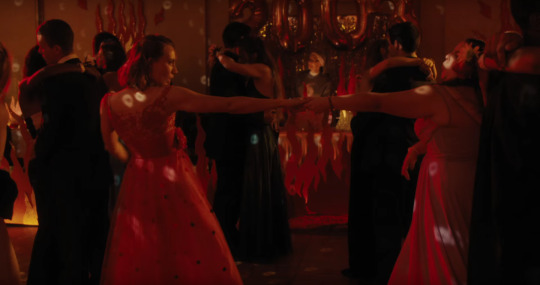
As much as this plot resembles an archetypal coming-of-age story, Lady Bird set itself apart with its odd, even poignant dialogue—filled to the brim with humor and character peculiarities—which shows the immense depth that enabled the film to be a near-perfect dramatization of what it feels like to live through seemingly romanticized situations while subtly subverting it through a realistic and relatable portrayal on-screen.
In this year’s Academy Awards, Lady Bird received numerous nominations in categories such as: Best Picture, Best Director, Best Actress, Best Supporting Actress (I mean seriously, Laurie Metcalf killed it) and Best Screenplay. Although it did not bag any awards in the end, many audiences including myself still consider Lady Bird an achievement—being such a lively coming-of-age tale, with its ability to touch hearts with its honesty, comedy and originality
Photo sources: 1 2 3
1 note
·
View note
Text
Wakanda Forever: A Black Panther Film Review

by Joel Anthony Lim
edited by Benjie Bernal
Black Panther (2018), the latest film in the blockbuster Marvel Cinematic Universe, is quickly becoming a cultural phenomenon. As one of the comic book creations of the powerhouse duo Stan Lee and Jack Kirby, Black Panther/ T’Challa is the first superhero of African descent, which was a revolutionary concept in the 1960s. The character was brought to life with a memorable arc that was highlighted in spite of being amidst the massive ensemble of Captain America: Civil War (2016) with a magnetic performance from Chadwick Boseman. And now, with the arrival of his solo film, kids can now look up to a new kind of hero that truly represents people of color in film.
Black Panther follows the titular character adjusting to his rule as king of Wakanda, a fictional African isolationist nation that’s the most technologically advanced country in the world because of their abundance of the metal vibranium. T’Challa’s unprepared, as he’s forced into his role after his father’s violent demise in Civil War. Now, he has to step up as a leader to both his family and friends, just as several enemies emerge to challenge his rule, such as arms dealer Ulysses Klaue (Andy Serkis) and the mysterious mercenary Erik Killmonger (Michael B. Jordan).
Director Ryan Coogler’s passionate direction of Black Panther, with help from Joe Robert Cole in penning the screenplay, gives vibrancy to its all-black cast and the beautiful, idyllic world of Wakanda. Mirroring how Stan Lee and Jack Kirby challenged racial barriers by creating the Black Panther in the height of racial issues, Coogler flips up the formula that has long permeated the Marvel Cinematic Universe (and most of today’s blockbusters) by delivering a movie that offers both the thrill of most MCU films have while diving into topical and relevant issues.

Wakanda is filled with striking color and beauty, filled with costumes by Ruth Carter and gorgeously shot by cinematographer Rachel Morrison, who’s the first female to be nominated for an Oscar for Best Cinematography for Mudbound (2017). From the vivid landscapes, the pouring waterfalls and the lively streets, it’s Afrofuturism portrays a massive appreciation and love for African culture. The vibrant action of the film also stands out with the car chase scene in South Korea, to the climactic final battle in the fields of Wakanda, to a memorable tracking shot in an Korean casino that rivals the intense one-shot boxing match in Creed (2015). Adding to the excitement is Ludwig Göransson’s majestic score and a soundtrack that features Kendick Lamar’s energetic style.
The film’s characters are both fully-realized with their own personal motives & distinct personalities and portrayed with dedication by a knockout cast. Winston Duke, Martin Freeman, Forest Whitaker and Andy Serkis are given great characters to work with, with the latter bringing both the menace and fun in Ulysses Klaue, who’s armed with both an arm cannon and a snark to boot, and he plays it with such glee that’s it’s enjoyable to see him wreak havoc while plugging his SoundCloud account.

All praises go to the eclectic number of strong women that populate the cast of Black Panther, from the legendary Angela Bassett as Queen Ramonda to Oscar winner Lupita Nyong’o as the pacifist spy (and T’Challa’s ex-girlfriend) Nakia. Letitia Wright is rightfully the breakout star of the film as the spunky and quirky Shuri, T’Challa’s sister and gadget-provider. Best of all is Danai Gurira as Okoye, the badass and mesmerizing head of the all-female Wakandan bodyguards known as the Dora Milaje.
Mad props to Chadwick Boseman, who doesn’t need the snark of other MCU heroes to mask his character’s insecurities and fears in finding his purpose as Wakanda’s new leader, and this brings a refreshing sincerity that sets him apart from his superhuman peers. And all the praise goes to Michael B. Jordan, who delivers an all-time great villain with Killmonger. It helps that Jordan is Coogler’s muse from all his films, and Jordan brings a terrifying intensity to Killmonger that it’s disarming yet convincing when he unveils the morality and heartbreak behind the relentless killer.

Black Panther is a well-made entry into the Marvel Cinematic Universe that delves into relevant issues, celebrates African culture and brings a fresh perspective in a movie universe we’re all too familiar with. And what makes it great is that there’s something here for everyone. For the casual viewer, it’s a fun and unique blockbuster. For fans of the comics, it’s fulfilling to see an iconic character finally make it on screen. And lastly for people of color, it’s about time we see them as the badass warriors who kick ass, inventors that rival Tony Stark’s, and heroes who make a difference both in the MCU, as well as real life.
Photo sources: 1 2 3 4
0 notes
Text
Film Review: The Greatest Showman
by Renzo Guevara
edited by Anna Cayco

The musical film genre has slowly but steadily been making its comeback to modern cinemas, as proven by the recent successes of film franchise Pitch Perfect and the hugely popular La La Land (2016). While some films may be more loved than others, there’s no denying that studios nowadays have been warming up to the idea of a musically driven narrative. People may not realize easily at first, but directing a musical is arguably harder than a normal film. Other than the fact that the director has to oversee the acting, writing, cinematography, etc., they must also make sure that the music and choreography hits the right beats when it comes to how and when they show up and how well they fit into the narrative. All these stacked on top of each other while making sure the pacing stays both consistent and engaging.
This is one of the biggest strengths of The Greatest Showman (2018), considering that it was directed by a relatively inexperienced director. For Michael Gracey, who’s mostly known for his visual effects work, this was his first directorial role and that in it of itself has its pros and cons.
To the film’s credit, it starts off with a high note with a musical number introducing us to the main character, P.T. Barnum (Hugh Jackman). The dream sequence reveals his troubled childhood and his mediocre job that barely supports his family. These first few minutes presents to us the main theme of what the film stands for: dreams. With songs like “The Greatest Show” and “A Million Dreams” coming in early in the film’s runtime, it immediately pulls in the viewer for one sublime experience that will definitely ignite some sort of spark inside. Throughout the entire runtime of the movie, a sense of passion and drive is felt with everything the characters do. It also helps with the fact that the film’s cinematography is visually stunning, considering Gracey’s experience. Though it may not have elaborated long takes or unique angles, every shot is still oozing with bright colors that pop and it does a great job at keeping things fresh and interesting.

A good example of this would be the sequence of the highly popular “Rewrite the Stars”. This was arguably the most popular song amongst the general public leading up to the film’s release to the point where it was already being played in the local radio stations. Going into the theater, I expected the song’s part in the film would feel somewhat redundant and all too familiar. Although the build up towards this moment is almost non-existent, the way the camera tracks Anne Wheeler (Zendaya) from the side while she walks away from Phillip (Zac Efron), who begins to sing the famous first few lines, was simple yet effective and had the entire theater I was in scream in delight.
Within all that shine and spectacle though comes a painfully mediocre script. This may have been a story about hopes and dreams but the heart of it has to come down to characters, who were so forgettable that I had to Google their names for me to be able to identify them. Other than P.T. Barnum and Charity Barnum (Michelle Williams), you’d be lucky to remember any of the names of the other characters, including Zac Efron and Zendaya’s. What’s mostly to blame here is the non-existent character development whatsoever. Even the cast of P.T. Barnum’s circus, who gave out a performance of their lives, was barely named and can only be remembered by their excellent costume and makeup design.
The highly anticipated love story between Zac Efron’s and Zendaya’s character had no development or build-up in any way. One scene would be them meeting for the first time and the next would be them immediately trying to awkwardly hold hands. It’s a shame that the backbone of this romance had a powerful message, especially in the time period the story takes place, but ultimately disappoints and results being no better than an above average romance sub-plot in a superhero movie.
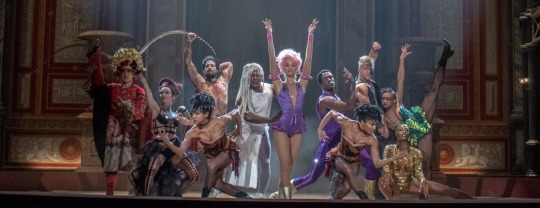
Ultimately, The Greatest Showman can only be categorized as a “moments” film. It has some good parts that hit the high notes but has a hollow skeleton connecting those scenes. The problems the characters encounter don’t feel like they have much weight to them because they are either solved or brushed off with just a few scenes later. Consequences, if they exist at all don’t feel like they’re taking a toll which is a shame considering that this story could have easily benefited from a little bit of tension.
The Greatest Showman’s bland writing and flat direction are only saved by the amazing soundtrack and vibrant cinematography at play. It’s a safe and fun watch for the whole family that will for sure tug at some heart strings. But in the end, it fails to meet its potential with its characters and becomes an underwhelming film all in all.
Photo sources: 1 2 3
#the greatest showman#film review#anna cayco#renzo guevarra#hugh jackman#zac efron#zendaya#michael gracey
0 notes
Text
A Tale Under the Stars

by Benjie Bernal and Miguel Santiago
edited by Joshua Chan
Fairytales operate on formula and archetypes that cement their position in one’s subconscious. Imagine – a distant land untouched by dust and grime with rolling green hills and living stars spelling out a love story as if it were destiny. A world where only heroes are allowed to reign with magical creatures roaming around freely. Ultimately, such realms born of our imagination are connected to our hearts’ desires, where we are all princes and princesses seeking for our own happily-ever-afters.
Under the Stars (UTS), an annual event organized by the Loyola Film Circle (LFC), then provides an opportunity for us, a community of dreamers, to gather and commemorate our stories. Held on the 15th of February from 7 PM until well past midnight, people riding the high of the infinite shades of love gathered together at Bellarmine Field for a fun-filled night presented with the theme of fairytale dreams come true.

Seve Carlos, 2 AB Com, appreciated how “the whole theme and the overall event [were] consistent with everything,” noting particularly the marriage booth and the LED balloons. Erika Tempongko, LFC’s President, also expressed her delight with this year’s theme: “What I enjoyed about the fairytale theme is that it’s relatable to all types of people. Even though Under the Stars has primarily been a romantic event, we have been trying to branch out to encourage people to invite their friends and family as well.”
In collaboration with the Ateneo Musician’s Pool (AMP), the event featured performances and films dedicated to immersing the crowd, complemented with unparalleled enthusiasm from hosts Rafa Chua, Howi Bakunawa, Ian Pangilinan, and Karla Habaluyas.

Musical performances this year featured the following acts: Last Name Basis, Dirty Old Sneakers, Bianca Abad, Our Inflatable Friends, Lance Salazar, Kali and Casey, and Bottom Space. Three student-produced films were also screened this year. These were Newbie Film Winner “10-Minute Break”, IsaPelikula Film winner “Jenny and the Staff of Magis”, and “And, Again”, the official UTS film produced by LFC’s ProdCore team. Lastly, the closing feature of this year’s Under the Stars was fitting to the theme of the whole event – the 2007 Disney musical-comedy “Enchanted” (d. Kevin Lima).

The mesmerizing collision of fantasy and “reality” in Enchanted offered a fitting conclusion to a night that followed the timeless formula of a fairy tale. And although there were some imperfections, they did nothing to extinguish the magic as laughter and love filled the air. In fact, after the clock struck twelve, we did not eradicate the lands of our stories; rather, we tucked them in storybooks big enough to hold galaxies. While the next time to gather and commemorate our stories once more on a beautiful night in a familiar field seems far, for now, we continue to live out our stories, patiently waiting to relive that magical night under the stars.
Note: Under the Stars 2018 was sponsored by McDonald’s and Junel Lights and Sounds Rental. Official media partners included Monster RX93.1, When in Manila, and Young Star.
0 notes
Text
Nexus: LFC 20′s Homecoming

by Miguel Santiago
edited by Anna Cayco
This can be how worldly things are transformed into works of art: through a lens, through lines upon lines of dialogue typed out across a word document, and through a cursor hovering above wavelengths of color and sound. As part of a film organization, most of our movies are fruits of our labor. We can think to ourselves, as we gaze upon a completed film: this must be what passion feels like. Presented in such a way, calling filmmaking a “hobby” is almost an understatement.
What does it even mean for something to be considered as “just a hobby”? This question is inevitable. So, too, are the following ones: “Is this something I want to keep on doing? Even after I graduate?” “Can I earn enough money for this to support myself?” Questions like these were no doubt at the forefront of every undergraduate’s mind when they were faced with LFC’s alumni, those who ended up pursuing their passion into the “real world.”
And isn’t this the real challenge? Outside of school, real life rarely provides you with the symmetry and natural lighting that fits your aesthetic. The future is unknowable, and because of this, it garners for itself a terrifying reputation. Establishing a support system, therefore, is considered a must for every aspiring filmmaker to “make it” with a future in that strange and unknowable industry. This is one of the many things that the LFC has stood for in what has now been twenty years.
On January 13, 2018, the organization celebrated this milestone in the form of a homecoming targeted to include both its graduates and undergraduates. Held at the Armory in Quezon City, the program was hosted by the current President, Erika Tempongko and Promotions Deputy, Thea Soriano. It featured a beautifully cut montage of films that LFC has produced over the years.

“Seeing our old work on screen at Homecoming really brought me back to the days we'd run around campus in the heat trying to get the best shot possible,” Janina Ignacio admitted, a graduate from Batch 2015 who is currently working for the Branding Department of a well-renowned hotel company.
But the past is not without its sorrows: presented also were videos dedicated to two beloved people of the LFC community that have already passed away: Francis Pasion, LFC’s founder, and Fr. Nick Cruz SJ, a film professor and critic who was well known for his cinema classes in the Ateneo.
Francis Pasion was fondly remembered for being outspoken about his love for filmmaking, and how it was because of his desire to share that love that the LFC was born. Fr. Nick was soft-spoken, but was just as passionate, with his classes serving to open a window into film appreciation that can be considered unrivaled. And despite technical difficulties, most of the returning alumni still felt the pull of nostalgia as they reminisced over these two dearly departed mentors.

Afterwards, the rest of the night was left open for the attendees to make the most out of. This, Tempongko claimed, is what she was most excited about that night, “There’s going to be games and stuff that will allow old and new members to mingle with each other, and I’m excited to see how that turns out!”
Previous and current members were given the freedom to mingle with each other in every way they could. Bonding by the beer pong table, doing their best to aim through the haze of smoke and free beer. Talking by the bar, leaning their heads together to have their voices heard over the throbbing bass. Dancing in front of the DJ, laughing at the image of raised hands and swaying hips under flashing lights.
Abby Cruz, from Batch 2015, admitted that she felt fortunate to be able to see her college barkada more often than others. However, she also said that it was “…more interesting [to see] the younger generations of LFC and [to meet] a lot of new and cool people. It’s always interesting to see who’s carrying on the LFC blood.”
Her statement is proof that there had been more to that night than those party-girl visions: a community had flourished then, lovers of a craft whose passions had been enriched by being allowed to mingle with generations past. In that brief moment in time, the future stopped being a completely frightening place. Here were people who “made it”, and they did so by doing what they loved. And if they could do it, then I can, too.

Trish Ocampo, from Batch 2015, served as the Internals VP during her time in the Ateneo. She is currently working as a musical theater actor. When asked if she had any advice for the undergraduates, for those who fear for passion fading under the harsh demands of the “real world,” she offered this heartfelt sentiment:
“Cheesy as it sounds: chase your dreams, go after your passions. Take it from someone who grew up around sentiments like: ‘An actor? Really?’ … Life's no walk in the park, it's true. There are gonna be challenges and crises no matter where you go or what industry you enter, but when you remind yourself everyday that you love what you're doing, you have a reason to fight on.”
0 notes
Text
IsaPelikula 4: Directing

by Dane Santiago
edited by Joshua Chan
On November 24, 2017, the fourth and final IsaPelikula class by the Loyola Film Circle featured director Prime Cruz to share with students about the processes of film directing. The acclaimed director provided general examples while also elaborating on some of his artistic decisions in the films Sleepless (2015) and Ang Manananggal sa Unit 23B (2016).

He began by describing the notion that people commonly have about directors: someone who orders people around on a set. Upon closer examination of their creative process, however, we see that directors are, in fact, doing a largely collaborative job. The director needs to understand how the other elements of the film (acting, editing, production design, etc.) communicate the main message that they seek to convey.
“You’re the first audience to your film,” Cruz says, “as you watch things unfold in front of your camera—your job is to determine whether you like what you’re seeing or not.” Additionally, what makes this step more complex is that directors have to choose between a lot of different elements—whether it’s the way the actor conveys a particular emotion, or the way the subject is framed by the camera. In this sense, being a ‘decision-maker’ or having such power over a film does not always entail an easy job, Cruz even muses on how it is more difficult to decide on a film’s overall message than its execution.
Whether you like what you’re seeing or not is largely determined by the answer to the question “what is the film trying to say?” To answer this question effectively, one must distill a single thought or emotion from the multiple messages that a director may be tempted to express. Because such a message is not always apparent from first sight, the director has to decide the one overarching thought, emotion, or statement that will be imbued in every shot and every scene of the movie.
As an example, Cruz described a certain feeling of riding the MRT – the feeling of looking out the window, engulfed by a feeling of overwhelm; both by the inside of the train and the sights and sounds of the city outside. Although this seems to be more on the side of imagery than a clear-cut statement, this ‘solid emotion’ is what inspired Cruz to depict the emotions of the character of Gem (portrayed by Glaiza de Castro) from his film Sleepless. In the film, overwhelmed by her graveyard job as a call center agent, Gem’s state of stasis and isolation is continually depicted by shots that feature a lot of empty space between her and other objects. Because Gem finds it difficult to express herself, the director often chose to have the characters do very subtle acting while the shots themselves express what Gem is not able to.

Cruz then gives another example from his other movie, Ang Manananggal sa Unit 23B. One scene is about Jewel (Ryza Cenon) being overpowered by a force within her (the titular ‘manananggal’). The actress was instructed to dramatize this very emotional scene, showing Jewel contorting out of a mixture of pain and pleasure. Aside from this acting, the director employed various other tricks—the foreground objects partially blocking her so she feels ‘unreachable’, the warm lighting, the creeping sound that continually escalated, and the slowly changing aspect-ratio (where the black frames at the top of and bottom of the screen slowly opened themselves upward just at the point that Jewel feels a ‘release’).
The latter trick—the changing aspect-ratio—surprised most people because it is something not easily noticed on first watch. Cruz noted that many people liked that scene but could not pinpoint why, and then added that it did not matter if it was not noticed on a technical or intellectual level – if people felt the emotions intended by the director for the scene, it has done its job well.
Lastly, to end the class, Cruz told everyone not to be too concerned with the ‘look’ or ‘polish’ of their own films. “You can get people to do that for you in the future,” he adds, “instead, be concerned with telling the story in your unique way.” He also assured the students that directing gets easier with practice over time, no matter the quality of the camera.
Cruz then ended by giving advice – picking out all the elements (acting/story/editing/mise-en-scene) from your personal top five films and find out why you like them and what the film’s message/tone/emotion does to tie these elements altogether. In the end, although the classroom setting was intimate (with the event held close to the final exam week), the room resounded with applause as the lecture adjourned.
#isapelikula#directing#prime cruz#sleepless#ang manananggal sa apartment 23b#joshua chan#dane santiago#events
0 notes
Text
Are Sci-Fi Sequels/Reboots Necessary?

by Raf Bautista
edited by Joshua Chan
Whenever the word “reboot” or “sequel” is mentioned, there are two reactions – a sigh of despair or a smile of happiness. Reboots and sequels are either able to bring a certain franchise back into the mainstream and win over new and old fans, or lose them and risk killing a franchise’s reputation. This very reason is why most people are excited or worried whenever a sequel or reboot is announced – there are serious pros and cons.

First off, the question of their necessity is always asked with supporters on both sides on the issue. There is no denying the risk of a bad sequel or reboot, especially if the first or original is held in high regard. Ironically, however, history has shown that some of the best sci-fi movies are sequels or reboots. A good example of the necessity of sci-fi reboots is the Star Trek reboot in 2009. Before 2009, Star Trek, despite having a big following, was seen by many as the ‘lesser Star Wars’. After JJ Abrams’ reboot, however, the movie was met with critical and commercial success and triumphantly brought Star Trek back to the mainstream, spawning a new Star Trek franchise with two more sequels and a new show. Needless to say, the reboot reinvigorated the franchise, introduced a whole new audience to it, and expanded the lore, story, and universe of the franchise.
On the sequel side of the spectrum, however, an example of the necessity of sci-fi sequels is this year’s Blade Runner: 2049 (2017). Despite the fact that the movie wasn’t a box office hit, it was critically acclaimed (appearing in many critics’ ‘Best of 2017’ list) and seen as a worthy successor to the original, despite the fact that the original is already well-regarded as one of the best movies in the genre.
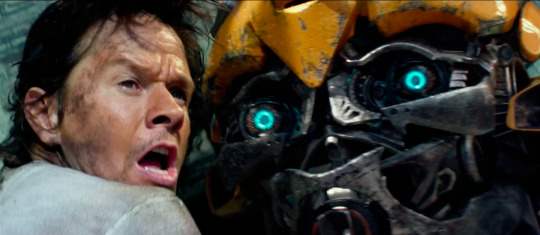
There are examples, however, of why sci-fi movies aren’t necessary and the Transformers franchise comes into mind. While the original received commercial success and somewhat lukewarm critical success, all the succeeding sequels have been increasingly awful and critically panned. In addition, the craft of the movie now seemed to be big, dumb action scenes, with the story taking a huge backseat. The film’s lore was now also a big confusing mess that is nearly impossible to comprehend. Although the series continues to make the money, it is the farthest thing possible from a good sci-fi franchise.
So, to answer the question if sci-fi sequels/reboots are necessary, the answer is yes, but only if it is done properly. People always want more stories told from the films they love, and that is what a good sequel/reboot can do. Sci-fi is also such a rich genre, as one is only limited by their own creativity. Thus, these reboots/sequels are necessary if done with love, care, and respect to the original source material.
Photo sources 1 2 3
#sci-fi#sequels#reboots#feature#transformers#star trek#blade runner#blade runner 2049#raf bautista#joshua chan
0 notes
Text
IsaPelikula 3: Sound and Editing
by Miguel A. Santiago
edited by Anna Cayco
Afternoon light colors your wide shot in such a way that no amount of post-processing can imitate. Fancy cameras capture the distance being closed between your two leading actors in a climactic kiss. Your innovative angles capture the world in motion no other film has ever done before.
Mastering these aspects of film are incredible feats on their own. But painting the world you want to make on screen with palettes of sound requires a totally different skillset. And weaving everything together to form a coherent masterpiece is a completely different beast to tame.
The third IsaPelikula (IsaPe) class provided members of the Loyola Film Circle (LFC) with tips on how to tackle these issues. On November 20, 2017, a class on Sound and Editing was held at Room 280A in the Social Sciences building. From 5-7 P.M., LFC was treated to lectures provided by names in the film industry with movies that have recently started making waves in Filipino mainstream culture.

The first lecturer for the night was Galileo Teo. He served as editor of Ang Manananggal sa Unit 23B (2016), The Debutante (2017), and Project Runway Philippines. He spent his session discussing his own editing process, and providing little tips as to how he makes the process easier for him. One thing that he emphasized throughout his segment was the importance of organization – to create folders upon folders. An “Audio” folder should be separated into the raw sounds and exported sounds while an “Edit” folder should be filled with the project files. One should keep a record of all the files that have already been exported and organize everything according to the camera used. All of these things are guaranteed to make the editing process easier.

The last segment of the class was hosted by Adi Lopez, the music producer of I’m Drunk, I Love You (2017) and Patintero: Ang Alamat ni Meng Patalo (2015). She introduced the different ways sound and music interacted with a scene or provided different layers of emotion. Throughout the lesson, she played commercials that she had helped create, and gave her insight on the processes relevant to her role in a particular production. To ease logistical concerns abounded in the lecture, when filming in a public place, it would help to time your shooting so that the space would be least occupied. Songs are cheaper to have covered than to purchase the actual track. Google can be a reliable search engine for SFX, foley, and other basic necessities for sound.
Both speakers were met with thunderous applause at the end of their segments. And despite this IsaPe class being scheduled on a Monday, with everyone still grumbling over the end of the weekend, their post-weekend lethargy did nothing to dampen their passion for learning about film.
Photos by Rica Bautista
0 notes